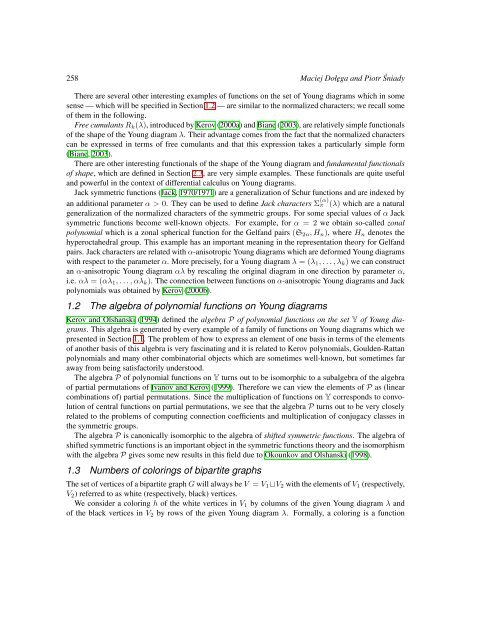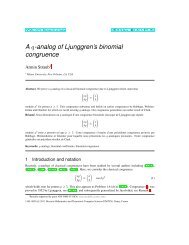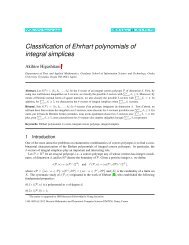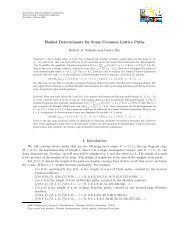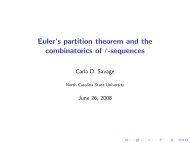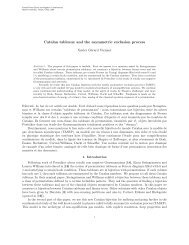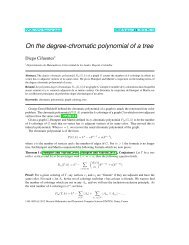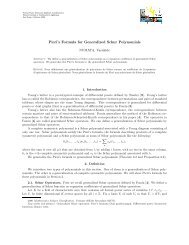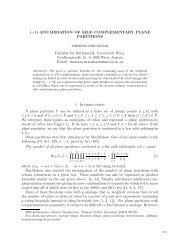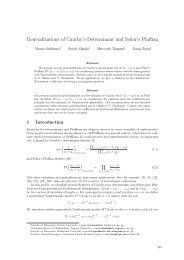Polynomial functions on Young diagrams arising from bipartite graphs
Polynomial functions on Young diagrams arising from bipartite graphs
Polynomial functions on Young diagrams arising from bipartite graphs
You also want an ePaper? Increase the reach of your titles
YUMPU automatically turns print PDFs into web optimized ePapers that Google loves.
258 Maciej Dołęga and Piotr Śniady<br />
There are several other interesting examples of <str<strong>on</strong>g>functi<strong>on</strong>s</str<strong>on</strong>g> <strong>on</strong> the set of <strong>Young</strong> <strong>diagrams</strong> which in some<br />
sense — which will be specified in Secti<strong>on</strong> 1.2 — are similar to the normalized characters; we recall some<br />
of them in the following.<br />
Free cumulants R k (λ), introduced by Kerov (2000a) and Biane (2003), are relatively simple functi<strong>on</strong>als<br />
of the shape of the <strong>Young</strong> diagram λ. Their advantage comes <strong>from</strong> the fact that the normalized characters<br />
can be expressed in terms of free cumulants and that this expressi<strong>on</strong> takes a particularly simple form<br />
(Biane, 2003).<br />
There are other interesting functi<strong>on</strong>als of the shape of the <strong>Young</strong> diagram and fundamental functi<strong>on</strong>als<br />
of shape, which are defined in Secti<strong>on</strong> 2.3, are very simple examples. These functi<strong>on</strong>als are quite useful<br />
and powerful in the c<strong>on</strong>text of differential calculus <strong>on</strong> <strong>Young</strong> <strong>diagrams</strong>.<br />
Jack symmetric <str<strong>on</strong>g>functi<strong>on</strong>s</str<strong>on</strong>g> (Jack, 1970/1971) are a generalizati<strong>on</strong> of Schur <str<strong>on</strong>g>functi<strong>on</strong>s</str<strong>on</strong>g> and are indexed by<br />
an additi<strong>on</strong>al parameter α > 0. They can be used to define Jack characters Σ (α)<br />
π (λ) which are a natural<br />
generalizati<strong>on</strong> of the normalized characters of the symmetric groups. For some special values of α Jack<br />
symmetric <str<strong>on</strong>g>functi<strong>on</strong>s</str<strong>on</strong>g> become well-known objects. For example, for α = 2 we obtain so-called z<strong>on</strong>al<br />
polynomial which is a z<strong>on</strong>al spherical functi<strong>on</strong> for the Gelfand pairs (S 2n , H n ), where H n denotes the<br />
hyperoctahedral group. This example has an important meaning in the representati<strong>on</strong> theory for Gelfand<br />
pairs. Jack characters are related with α-anisotropic <strong>Young</strong> <strong>diagrams</strong> which are deformed <strong>Young</strong> <strong>diagrams</strong><br />
with respect to the parameter α. More precisely, for a <strong>Young</strong> diagram λ = (λ 1 , . . . , λ k ) we can c<strong>on</strong>struct<br />
an α-anisotropic <strong>Young</strong> diagram αλ by rescaling the original diagram in <strong>on</strong>e directi<strong>on</strong> by parameter α,<br />
i.e. αλ = (αλ 1 , . . . , αλ k ). The c<strong>on</strong>necti<strong>on</strong> between <str<strong>on</strong>g>functi<strong>on</strong>s</str<strong>on</strong>g> <strong>on</strong> α-anisotropic <strong>Young</strong> <strong>diagrams</strong> and Jack<br />
polynomials was obtained by Kerov (2000b).<br />
1.2 The algebra of polynomial <str<strong>on</strong>g>functi<strong>on</strong>s</str<strong>on</strong>g> <strong>on</strong> <strong>Young</strong> <strong>diagrams</strong><br />
Kerov and Olshanski (1994) defined the algebra P of polynomial <str<strong>on</strong>g>functi<strong>on</strong>s</str<strong>on</strong>g> <strong>on</strong> the set Y of <strong>Young</strong> <strong>diagrams</strong>.<br />
This algebra is generated by every example of a family of <str<strong>on</strong>g>functi<strong>on</strong>s</str<strong>on</strong>g> <strong>on</strong> <strong>Young</strong> <strong>diagrams</strong> which we<br />
presented in Secti<strong>on</strong> 1.1. The problem of how to express an element of <strong>on</strong>e basis in terms of the elements<br />
of another basis of this algebra is very fascinating and it is related to Kerov polynomials, Goulden-Rattan<br />
polynomials and many other combinatorial objects which are sometimes well-known, but sometimes far<br />
away <strong>from</strong> being satisfactorily understood.<br />
The algebra P of polynomial <str<strong>on</strong>g>functi<strong>on</strong>s</str<strong>on</strong>g> <strong>on</strong> Y turns out to be isomorphic to a subalgebra of the algebra<br />
of partial permutati<strong>on</strong>s of Ivanov and Kerov (1999). Therefore we can view the elements of P as (linear<br />
combinati<strong>on</strong>s of) partial permutati<strong>on</strong>s. Since the multiplicati<strong>on</strong> of <str<strong>on</strong>g>functi<strong>on</strong>s</str<strong>on</strong>g> <strong>on</strong> Y corresp<strong>on</strong>ds to c<strong>on</strong>voluti<strong>on</strong><br />
of central <str<strong>on</strong>g>functi<strong>on</strong>s</str<strong>on</strong>g> <strong>on</strong> partial permutati<strong>on</strong>s, we see that the algebra P turns out to be very closely<br />
related to the problems of computing c<strong>on</strong>necti<strong>on</strong> coefficients and multiplicati<strong>on</strong> of c<strong>on</strong>jugacy classes in<br />
the symmetric groups.<br />
The algebra P is can<strong>on</strong>ically isomorphic to the algebra of shifted symmetric <str<strong>on</strong>g>functi<strong>on</strong>s</str<strong>on</strong>g>. The algebra of<br />
shifted symmetric <str<strong>on</strong>g>functi<strong>on</strong>s</str<strong>on</strong>g> is an important object in the symmetric <str<strong>on</strong>g>functi<strong>on</strong>s</str<strong>on</strong>g> theory and the isomorphism<br />
with the algebra P gives some new results in this field due to Okounkov and Olshanski (1998).<br />
1.3 Numbers of colorings of <strong>bipartite</strong> <strong>graphs</strong><br />
The set of vertices of a <strong>bipartite</strong> graph G will always be V = V 1 ⊔V 2 with the elements of V 1 (respectively,<br />
V 2 ) referred to as white (respectively, black) vertices.<br />
We c<strong>on</strong>sider a coloring h of the white vertices in V 1 by columns of the given <strong>Young</strong> diagram λ and<br />
of the black vertices in V 2 by rows of the given <strong>Young</strong> diagram λ. Formally, a coloring is a functi<strong>on</strong>


